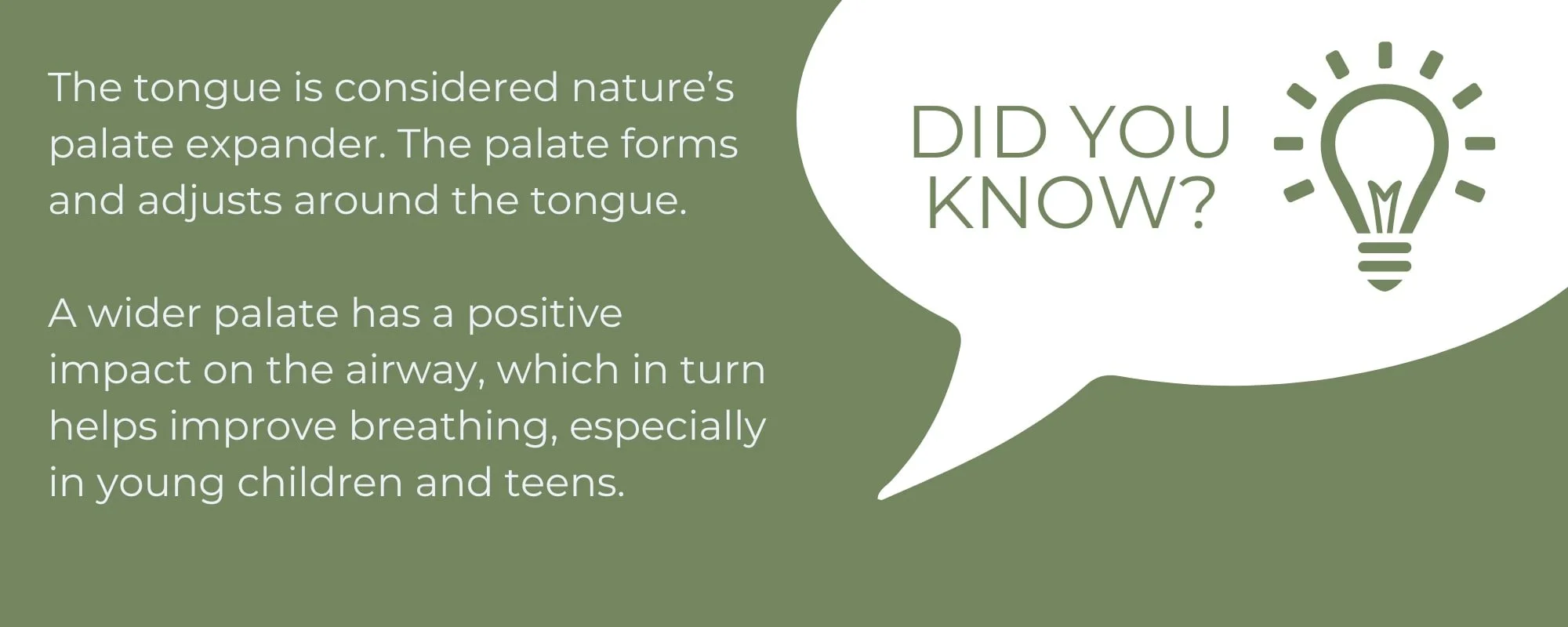Straight Talk on Jaw Pain
Unlock relief from jaw pain with practical tips on optimizing tongue position. Learn how simple adjustments can make a big difference in managing discomfort and promoting overall well-being.
Have you ever taken a moment to think about your tongue? We use it to eat and speak, but did you know that it plays a critical role in jaw development and breathing and could contribute to your jaw pain?
In this blog post, we will identify the ideal resting tongue posture, examine how tongue posture plays a role in a healthy jaw, discuss how tongue ties can impact our jaw, and discuss what we can do when our tongue doesn’t want to do what we want it to.
Is your tongue in its proper place?
As you read this, take a moment to focus on your tongue. Specifically, I want you to try to figure out how it’s sitting in your mouth. Is it A, B, C, or D?
When I ask my patients if they are able to identify where their tongue is currently sitting, 9 times out of 10, the answer I get is I don’t actually know….it’s just there.
What is the ideal resting tongue posture?
In short, the correct answer is D. If you think of the “N” sound, that’s where the tip should be placed. Pretty easy right? Most of us have this part down pat. Now, Say the word “king” or “ring”. The “ng” sound is where the back of the tongue should be. This one is more challenging and definitely not as easy.
When you aren’t eating or talking, your entire tongue should be suctioned to the roof of your mouth, with the tip just behind the front teeth. Your teeth should be slightly apart, and your lips should be sealed. Your tongue should not press on any teeth whatsoever.
Any deviation from this positioning could contribute to issues such as:
forward head posture
TMJ Dysfunction
Sleep Disordered Breathing
Jaw and neck pain
Tooth Damage
Most of my patients have a resting posture of A, B, or C. The tip is in the right spot, but not the rest of the tongue.
So you might be saying this is all great but my tongue can’t / won’t go up to the roof of my mouth no matter how hard I try. Now what?
Tongue ties (Ankyloglossia)
If you can’t bring the tongue to the roof of your mouth, there’s a chance that a tongue tie could be at play. Believe it or not, Anywhere between 4.2% and 10.7% of babies are born with some kind of tongue tie! However, tongue ties can be tricky and aren’t always visible to the naked eye.
Symptoms for Adults may include:
neck and shoulder tension
headaches or migraines
sleep difficulties (snoring, teeth grinding, sleep apnea, poor quality sleep, feeling fatigued/brain fog)
sometimes slow eating or trouble swallowing pills,
speech difficulties (gets tired when talking, mumbling, stuttering, or a history of speech therapy or speech delay as a child)
This list is just a snapshot of symptoms. Check out the list below from the Alabama Tongue Tie Center to see how many symptoms you have.
Speech Issues
Speech is harder to understand in long sentences
Others have a hard time understanding speech
Jaw gets tired when talking or reading aloud
Difficulty getting certain words out
Embarrassed by communication
Mumbling or speaking softly
Shy in social situations
Difficulty speaking fast
Trouble with sounds
Difficulty singing
Speech therapy
Speech delay
Stuttering
Sleep Issues
Poor quality sleep
Wake easily or often
Snore while sleeping
Sleep with mouth open
Grind teeth while sleeping
Sleep in strange positions
Move around a lot at night
Wake up tired and not refreshed
Sleep appliance or CPAP needed at night
Gasp for air or stop breathing (sleep apnea)
Feeding Issues
Breastfed or Bottle-fed as a baby
Fussy, colicky, or “difficult” as a baby
Frustrated when eating currently
Slow eater (last one to finish a meal)
Small appetite
Graze on food throughout the day
Pack food in cheeks
Picky with textures
Difficulty swallowing pills
Choking or gagging on food or water
Breathing Issues
Trouble breathing through the nose
Mouth open / mouth breathing during the day
Tonsils or adenoids removed previously
Sinus issues or sinus surgery
Teeth extracted for braces
Jaw surgery in the past
Other Related Issues
Neck or shoulder pain or tension
TMJ Pain, clicking or popping
Headaches or migraines
Strong gag reflex
Prolonged thumb sucking
Ear tubes previously or lots of ear infections
Reflux (if so, medication?)
Constipation
Hyperactivity/inattention
Stress or anxiety
Trouble or pain with kissing/intimacy
Don’t hold chiropractic adjustments well
Having a tongue tie assessed is more than just being able to stick out your tongue. Some ties are deeper in the tongue and don’t stop the tongue from being able to do this. If you think you may have a tongue tie, please consult a trusted healthcare practitioner well-versed in tethered tissues including but not limited to:
Family physician,
ENT Doctor,
Functional Dentist,
Myofunctional Therapist.
Please keep in mind that not all ties need to be released. This is why it’s important to consult someone who is well-versed in this subject matter.
The connection between TMJ Disorder and Tongue Ties
Tongue Ties and Forward Head Posture
When the tongue is restricted, it can impact the way you speak, eat, and breathe. Because it is unable to adopt its proper resting posture (up at the roof of the mouth), the tongue has a low posture, which in turn impacts the size of your airway. Your head starts to come forward (forward head posture) to pull the tongue away from the airway, creating more space so that you can breathe.
This forward head posture overworks the muscles of the upper back, neck, shoulders, and jaw, which can lead to jaw pain, facial pain, and headaches, just to name a few.
Tongue ties and bruxism (clenching/grinding)
More times than not, our clenching/grinding at night (aka sleep bruxism) gets attributed to stress. This is only partially true. It’s not the psychological kind of stress but actually the physiological type.
We know the tongue should be suctioned to the roof of the mouth at rest. If it is anywhere but there, it has a tendency to fall back into the throat while you are sleeping. If you can’t breathe while you are sleeping because your tongue is flopping back and restricting the airflow, your brain isn’t getting enough oxygen. Hence, it tries to put your body (restless sleep) and jaw (bruxism) in a better position to clear the airway to get more oxygen.
How does tongue posture impact your overall health?
Good tongue posture has a positive effect on health in the same way that poor tongue posture has a negative effect on health. Good tongue posture includes the likelihood that your teeth will be better aligned.
Effects of poor tongue posture
You may not realize that some of your issues can stem from where your tongue is positioned in your mouth. One good example is halitosis.
Halitosis is the clinical term for really bad breath—the kind that could kill a dragon. If you have good oral hygiene skills but are still struggling to get this condition under control, ask yourself: Where’s my tongue sitting? Am I breathing through my mouth?
Chances are your tongue is not in its ideal resting posture which in turn leads to mouth breathing. This kind of breathing pattern messes with the delicate balance of the microbiome of your mouth.
How can I improve my tongue posture?
Just like the other muscles of your body, there are certain exercises you can do to retrain your tongue to hold proper posture. Before you head to the internet to search out tongue exercises, here are a few things to consider before you start:
Awareness is key! Set random timers to go off throughout the day to check in on your tongue posture. You want the whole tongue up at the roof, not just the tip!
Knowledge is power! Meet with a Myofunctional Therapist for a complete assessment. They are trained to identify what is happening and will be able to guide you throughout the entire process and tell you which exercises you need to do to restore proper tongue function.
It is important to note that your jaw pain could get worse as you do this. If that’s the case, please stop what you are doing and consult a healthcare practitioner well-versed in TMJ Dysfunction.
It's clear that paying attention to how the tongue sits in the mouth is super important for keeping our jaws healthy and feeling good overall. Getting the tongue in the right spot can help prevent all kinds of problems like neck and shoulder tension, headaches, and even trouble sleeping.
It might be worth chatting with a knowledgeable healthcare provider if you're struggling with tongue posture. Small changes can make a big difference, so don't stress too much—just keep trying to get that tongue in the right place, and you'll be on the right track to feeling better.
About the Author
Jeannine Weddell, RMT, is a registered massage therapist with the CMTO. With a passion for holistic wellness, Jeannine is dedicated to helping clients find relief from jaw pain. For more information or to schedule an appointment, visit www.mlniagara.janeapp.com.
This blog provides general information and discussions about health and related subjects. The information and other content provided in this blog, website or in any linked materials are not intended and should not be considered, or used as a substitute for, medical advice, diagnosis or treatment.






